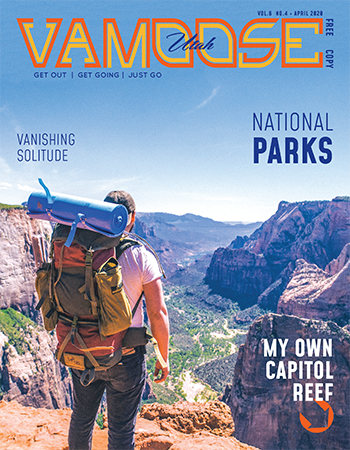Only in Utah can you enjoy year-round warm-water diving—in a limestone crater, no less.
Utah may boast numerous outdoor options, including skiing, climbing, mountain and road biking, river rafting, kayaking, and ATV riding. But, is that really enough? Apparently not for me, since I’ve added another recreational opportunity you might not identify with the Beehive State: diving.
I didn’t discover diving in Utah, however. That would have been on the sunny shores of Cancun. A few years back, my now-wife/then-girlfriend and I were in Mexico. She had loved to SCUBA dive for years, but not me. I was petrified of water—especially being under it. But as we were staying at an all-inclusive hotel, I had a few drinks, and a free session with SCUBA gear was offered at the pool. Well, one thing led to another, and before I knew it, I was headed out on a boat the next day.
I figured, at a minimum, I would receive some instruction in the pool and get a free boat ride afterward. What could possibly go wrong? A three-minute boat ride later, still in earshot of the hotel pool’s music, I found out.
If Wile E. Coyote operated the ACME SCUBA company, this would be it. The buoyancy control devices (inflatable vests also known as BCDs) had broken buckles, the tanks had no air and the instructor spoke Polish. We were in Mexico, remember? A native English speaker trying to communicate with a native Polish speaker in broken Spanish sucks. I asked her what to do if I panicked when I was 30 feet under. All I could get back in response was: “You’ll have fun!” Yeah, I’m sure.
The first dive dropped us into a pretty cool reef. Maybe this would be fun. My mask wasn’t leaking, but it was tight as hell. I could breathe, so that was good. The instructor told us when the first diver’s air tank got down to 25 percent, we should surface and that we should breathe slowly to extend the dive. I sucked my oxygen down as fast as I could.
Once it was time to go up to the surface, I confused the “inflate” and “deflate” buttons and wound up filling the BCD too fast and rocketed to the surface. Not ideal, but I wrestled my mask off to take the best breaths of my life. My face was completely black and blue from the mask, because I didn’t know I was supposed to “equalize” the pressure in it on the way down. Another point lost in translation, I guess.
I lived, obviously. But, as soon as we returned to Utah, I signed up for a class at Dive Utah (4679 S. 2225 East, Holladay, 801-277-3483, DiveUtah.com) where I learned how to equalize a mask—and a lot more. Like, which button is used to inflate and which deflates. And, as you rise to the surface, the air in your vest naturally expands (remember high school physics class?), so you actually want to deflate your vest as your surface.

Homestead Crater
Over four pool sessions, I spent hours mastering techniques for SCUBA diving, and at that point, I was ready to take the plunge again. But first, I had to do four certification dives, which I did on a snowy December weekend at the Homestead Crater (700 N. Homestead Drive, Midway, 435-657-3840, HomesteadResort.com).
The crater is a geothermal spring under a 55-foot-tall dome of limestone rock. A hole at the top allows in light and air, but the water inside maintains a constant year-round temperature of between 90 and 96 degrees F.
As the only warm-water SCUBA diving destination in the continental United States, the crater is awesome for a dive in the dead of winter. There’s no need for a wetsuit. This natural feature is thousands of miles from the Mayan Riviera, but it’s less than hour from the Wasatch Front and is just as warm and clear.
Before my wife and I return to Mexico this winter, we’ll head up to Midway to knock off any rust, brush up on gear operation and hand signals. With the confidence I gained in Utah waters, I can hop a flight to Mexico, Belize, Thailand or Australia and be relatively self-sufficient and safe. And, there’s actually a plethora of dive spots in Utah (see below) from St. George to Salt Lake County, summer and winter.
Just as getting a drink at a beachfront all-inclusive resort is different from ordering one in a Utah bar, exploring Utah lakes is vastly different from diving in the ocean. Going from saltwater to freshwater adds to the unique challenge found in Utah waters, due to differences in buoyancy. Plus, the state’s higher elevation throws yet another curve at Utah divers. The ocean is (duh) at sea-level, so the way you approach diving at 6,000 feet—in the “thin mountain air”—means there is less atmospheric pressure. This needs to be accounted for in a diver’s gauges, as well as with the ascension rate. A miscalculation, or using the same dive rates as at sea level, can result in nitrogen building up in blood, aka the bends.
And while you have to rely on hand signals underwater, learning the skills from someone who speaks the same language is always a smart idea.

Where Else Can You Dive in Utah?
Sand Hollow Reservoir
This St. George lake is a cool place to dive: There is a submerged Cessna plane and VW bus at 40 feet to explore. Great place to beat the desert summer heat or enjoy spring and fall dives in comfortable water temperatures.
Bear Lake
Cold, with a capital C, unless you hit this turquoise blue lake on the Utah-Idaho border in the heat of summer. Or, simply wear a wetsuit. Here, you’ll see a graveyard of sunken cars and other high Alpine marine life.
SEABase
Located in the Bonneville Salt Flats, this is another unique place to dive, or learn to dive, as there is an on-site diving school (Visit Seabase.net). Water visibility can be low to zero here, but hey, you’re SCUBA diving in Utah.



